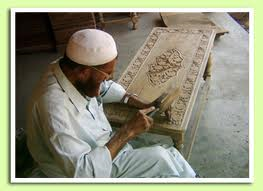
(Credit: valleyswat.net)
MINGORA, June 23: Artists from Swat skilled in relief carving and sculpting wood have urged government and non-government organisations to support them in conserving the craft. Woodcarving was once widely practised in the region during the ancient Uddiyana Kingdom, purported to be located in the valley.
Woodcarving in Swat can be traced back to the early Buddhist period of Kushan rulers and glimpses of the Greco-Buddhist style are still visible in furniture, buildings and monuments across the valley.
The delicate strokes represent the area’s tradition, culture and heritage, while their intricate floral designs represent Swat’s history and its civilization.
The craft has been passed on from generation to generation and is still a source of livelihood for several families. Although the number of carvers has dwindled, the quality of their work has not suffered.
Keeping the chisels busy
Nasar Sheen, a renowned woodcarver from Swat said, “The artist inside me was woken by the great Gandharan art reflected in buildings and structures around me. I began carving in my childhood but with the idea of taking the ancient craft into the modern era,” said Sheen.
“In a way, woodcarving is an inherent part of our culture. We see it on furniture, doors, pillars and it has been with us for a long time.”
Sheen has not learnt the art from a teacher; several of his friends are artists who taught him. “In truth, my teacher is Ghandharan art which I am surrounded by,” says the carver. His works uphold themes of strong cultural values, women’s education, peace, human rights, culture and music.
Artists, archaeologists and cultural activists in Swat say this unique art needs the attention for its conservation and promotion. “Frequent exhibitions on a national and international level will not only promote the art but also will encourage artists to improve their work. Later generations will also be motivated to learn the craft, which will keep it alive,” added Sheen.
In the eyes of the world
Sir Aurel Stein, a British-Hungarian archaeologist who visited Swat in 1926 wrote a book on his time in the valley. In An Archaeological Tour in Upper Swat and Adjacent Hill Tracts, Stein says, “The other local craft of Upper Swat retains evidence of the ancient skill that is woodcarving.”
Commenting on the quality and beauty of the craft, Stein writes, “I was struck by the amount of woodcarving, old and new, to be seen in mosques and houses.
These traditions clearly left their mark in a variety of decorative motifs of purely Greco-Buddhist style, plentifully displayed in the woodcarving on the pillared loggias of mosques and on the doors of headmen’s houses.”
Indology professor Doris Meth Srinivasan in her article ‘The Tenacity of Tradition: Art From the Valley of Swat’ states, “On land nestled between peaks that thrust higher than 5,500 metres, a rich artisanal tradition has flourished that reflects cultural intermingling that has taken place there. Among the varied artistic traditions of the Islamic world, the art of the Vale of Swat is unique.”
Published in The Express Tribune, June 23rd, 2014.

